The Barrier Resins Market is estimated to be valued at USD 8.9 billion in 2025 and is projected to reach USD 14.1 billion by 2035, registering a compound annual growth rate (CAGR) of 4.7% over the forecast period.
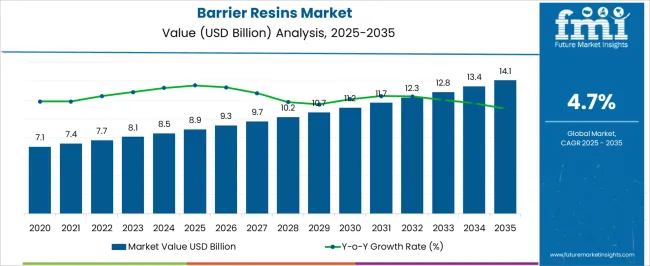
| Metric | Value |
|---|---|
| Barrier Resins Market Estimated Value in (2025 E) | USD 8.9 billion |
| Barrier Resins Market Forecast Value in (2035 F) | USD 14.1 billion |
| Forecast CAGR (2025 to 2035) | 4.7% |
The Barrier Resins market is experiencing robust expansion, primarily supported by the increasing demand for advanced packaging solutions that provide enhanced protection against moisture, oxygen, and other external contaminants. Industries such as food and beverage, pharmaceuticals, and personal care are prioritizing packaging that ensures extended shelf life, product safety, and compliance with strict regulatory standards. The ability of barrier resins to maintain flavor, aroma, and nutritional content is driving their integration into modern packaging designs.
Growing consumer awareness regarding sustainable and secure packaging is further boosting demand for resins with recyclability and lower environmental impact. Advances in polymer science and material engineering have enabled the production of lightweight, durable, and cost-effective barrier resins, supporting wide-scale adoption.
Moreover, the rise in e-commerce, global trade, and ready-to-consume packaged foods has strengthened the need for resilient packaging materials that can withstand long transportation cycles while maintaining product integrity With increasing investments in packaging innovation and the emergence of high-performance resins tailored to diverse end uses, the Barrier Resins market is projected to experience sustained growth across both developed and developing economies.
The barrier resins market is segmented by packaging type, resin type, application, and geographic regions. By packaging type, barrier resins market is divided into Flexible and Rigid. In terms of resin type, barrier resins market is classified into PVC, EVA, Polyethylene Naphthalate, Polyamide, PET, Polyethylene, Polypropylene, PVA, and Others. Based on application, barrier resins market is segmented into Food And Beverage, Pharmaceutical & Medical, Cosmetics, Agriculture, Industrial, and Others. Regionally, the barrier resins industry is classified into North America, Latin America, Western Europe, Eastern Europe, Balkan & Baltic Countries, Russia & Belarus, Central Asia, East Asia, South Asia & Pacific, and the Middle East & Africa.
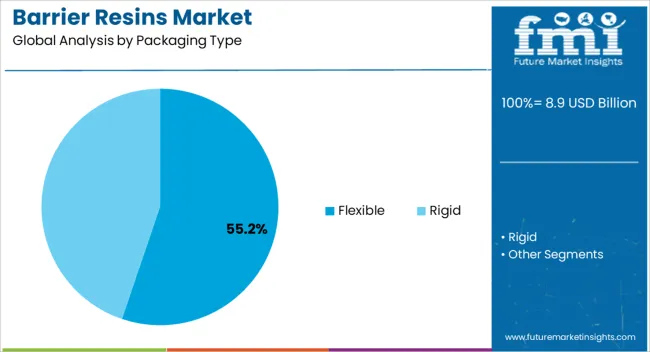
The flexible packaging type segment is projected to hold 55.2% of the Barrier Resins market revenue in 2025, positioning it as the leading packaging format. Growth in this segment is primarily driven by the rising consumer preference for lightweight, convenient, and portable packaging solutions that combine functionality with sustainability. Flexible packaging provides strong protection against environmental factors, ensuring extended shelf life for perishable goods while reducing material usage compared to rigid packaging formats.
Manufacturers benefit from cost savings in production, storage, and logistics, as flexible packaging allows for optimized transportation and lower energy consumption. The adaptability of flexible formats, such as pouches, wraps, and bags, supports their adoption across diverse industries including food, pharmaceuticals, and personal care.
Barrier resins play a critical role in enhancing the protective qualities of these flexible materials, enabling superior resistance to oxygen and moisture With increasing demand for user-friendly packaging that aligns with eco-conscious practices and delivers value across the supply chain, flexible packaging is expected to retain its leadership position in the market.
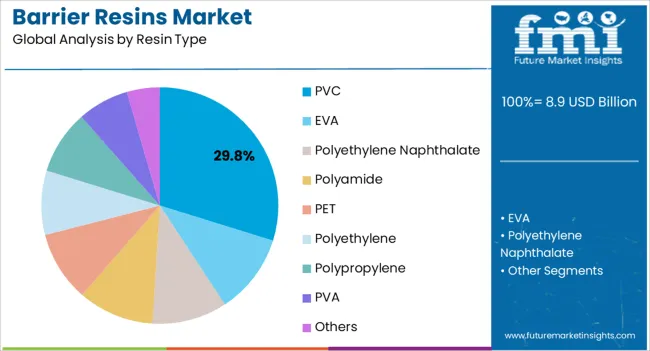
The PVC resin type segment is expected to capture 29.8% of the Barrier Resins market revenue share in 2025, reinforcing its role as a key material in packaging applications. PVC offers excellent clarity, strong barrier properties, and versatile processing capabilities, making it a preferred choice for manufacturers seeking cost-effective and high-performance solutions. Its resistance to moisture and gas permeation ensures product stability, especially in sensitive applications such as pharmaceuticals, food packaging, and medical devices.
The segment benefits from its ability to support customization in thickness and structure, which allows manufacturers to tailor packaging performance to specific product requirements. Additionally, PVC-based barrier resins are being increasingly enhanced with additives and coatings to improve recyclability and environmental performance, aligning with global sustainability goals.
The widespread adoption of PVC in blister packs, shrink films, and flexible wraps demonstrates its adaptability across sectors As industries continue to emphasize secure and efficient packaging with regulatory compliance, PVC resins are projected to maintain a significant presence, driving long-term demand within the market.
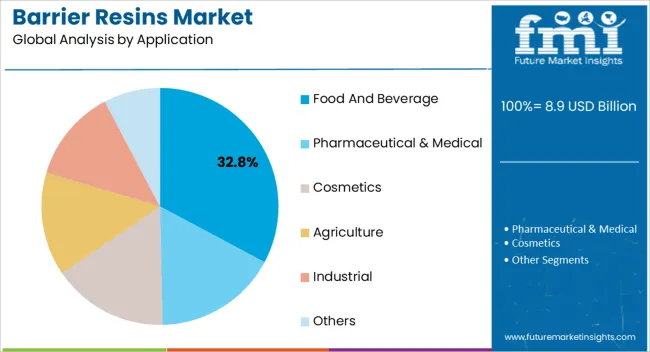
The food and beverage application segment is anticipated to account for 32.8% of the Barrier Resins market revenue in 2025, establishing itself as the leading end-use industry. This growth is primarily supported by the increasing demand for packaged foods and beverages that maintain freshness, quality, and nutritional integrity throughout extended supply chains. Barrier resins are crucial in protecting products from oxygen and moisture, thereby preventing spoilage and ensuring food safety.
With the rise in global consumption of processed and ready-to-eat foods, manufacturers are prioritizing packaging that offers both durability and transparency to meet consumer preferences. The segment is also benefiting from advancements in multilayer film technologies, which integrate barrier resins to enhance protective properties while reducing material consumption.
Regulatory requirements for food safety and growing emphasis on reducing food waste are further fueling adoption As consumer lifestyles continue to shift toward convenience and on-the-go consumption, the reliance on barrier resins in food and beverage packaging is expected to expand, reinforcing the segment’s leadership in driving market revenues.
Coniferous trees and other plants can naturally contain resin. Resin is a viscous, thick substance that may be turned into polymers in polymer chemistry. Such viscous and sticky compounds may be obtained from plants or manufactured. Organic chemical combinations are the most common causes. Resins are typically produced by plants to protect themselves from harm. In order to safeguard medications and other pharmaceutical items and lengthen their shelf lives, barrier resin use has risen throughout the world's pharmaceutical sectors. It is a kind of plastic that is used in packaging to stop liquid, gas, or air from penetrating the container. These explanations explain why the agricultural, chemical, food, and beverage sectors all require barrier resins.
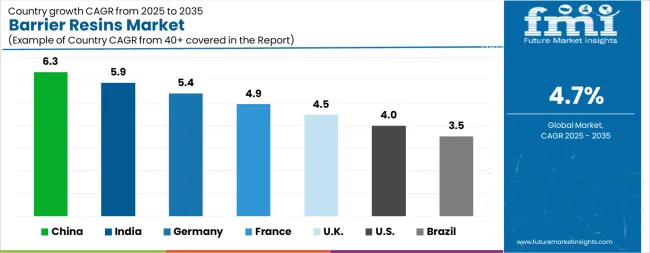
| Country | CAGR |
|---|---|
| China | 6.3% |
| India | 5.9% |
| Germany | 5.4% |
| France | 4.9% |
| UK | 4.5% |
| USA | 4.0% |
| Brazil | 3.5% |
The Barrier Resins Market is expected to register a CAGR of 4.7% during the forecast period, exhibiting varied country level momentum. China leads with the highest CAGR of 6.3%, followed by India at 5.9%. Developed markets such as Germany, France, and the UK continue to expand steadily, while the USA is likely to grow at consistent rates. Brazil posts the lowest CAGR at 3.5%, yet still underscores a broadly positive trajectory for the global Barrier Resins Market. In 2024, Germany held a dominant revenue in the Western Europe market and is expected to grow with a CAGR of 5.4%. The USA Barrier Resins Market is estimated to be valued at USD 3.1 billion in 2025 and is anticipated to reach a valuation of USD 4.6 billion by 2035. Sales are projected to rise at a CAGR of 4.0% over the forecast period between 2025 and 2035. While Japan and South Korea markets are estimated to be valued at USD 421.6 million and USD 302.8 million respectively in 2025.
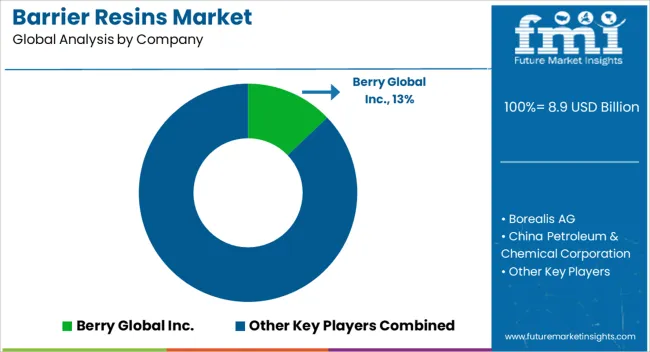
| Item | Value |
|---|---|
| Quantitative Units | USD 8.9 Billion |
| Packaging Type | Flexible and Rigid |
| Resin Type | PVC, EVA, Polyethylene Naphthalate, Polyamide, PET, Polyethylene, Polypropylene, PVA, and Others |
| Application | Food And Beverage, Pharmaceutical & Medical, Cosmetics, Agriculture, Industrial, and Others |
| Regions Covered | North America, Europe, Asia-Pacific, Latin America, Middle East & Africa |
| Country Covered | United States, Canada, Germany, France, United Kingdom, China, Japan, India, Brazil, South Africa |
| Key Companies Profiled | Berry Global Inc., Borealis AG, China Petroleum & Chemical Corporation, Exxon Mobil Corporation, Formosa Plastics Group, INEOS, LG Chem, LyondellBasell Industries, Mitsubishi Chemical Corporation, SABIC, Solvay, The Dow Chemical Company, Toyo Seikan Group Holdings Co., Ltd., and Westlake Chemical Corporation |
The global barrier resins market is estimated to be valued at USD 8.9 billion in 2025.
The market size for the barrier resins market is projected to reach USD 14.1 billion by 2035.
The barrier resins market is expected to grow at a 4.7% CAGR between 2025 and 2035.
The key product types in barrier resins market are flexible and rigid.
In terms of resin type, pvc segment to command 29.8% share in the barrier resins market in 2025.






Our Research Products

The "Full Research Suite" delivers actionable market intel, deep dives on markets or technologies, so clients act faster, cut risk, and unlock growth.

The Leaderboard benchmarks and ranks top vendors, classifying them as Established Leaders, Leading Challengers, or Disruptors & Challengers.

Locates where complements amplify value and substitutes erode it, forecasting net impact by horizon

We deliver granular, decision-grade intel: market sizing, 5-year forecasts, pricing, adoption, usage, revenue, and operational KPIs—plus competitor tracking, regulation, and value chains—across 60 countries broadly.

Spot the shifts before they hit your P&L. We track inflection points, adoption curves, pricing moves, and ecosystem plays to show where demand is heading, why it is changing, and what to do next across high-growth markets and disruptive tech

Real-time reads of user behavior. We track shifting priorities, perceptions of today’s and next-gen services, and provider experience, then pace how fast tech moves from trial to adoption, blending buyer, consumer, and channel inputs with social signals (#WhySwitch, #UX).

Partner with our analyst team to build a custom report designed around your business priorities. From analysing market trends to assessing competitors or crafting bespoke datasets, we tailor insights to your needs.
Supplier Intelligence
Discovery & Profiling
Capacity & Footprint
Performance & Risk
Compliance & Governance
Commercial Readiness
Who Supplies Whom
Scorecards & Shortlists
Playbooks & Docs
Category Intelligence
Definition & Scope
Demand & Use Cases
Cost Drivers
Market Structure
Supply Chain Map
Trade & Policy
Operating Norms
Deliverables
Buyer Intelligence
Account Basics
Spend & Scope
Procurement Model
Vendor Requirements
Terms & Policies
Entry Strategy
Pain Points & Triggers
Outputs
Pricing Analysis
Benchmarks
Trends
Should-Cost
Indexation
Landed Cost
Commercial Terms
Deliverables
Brand Analysis
Positioning & Value Prop
Share & Presence
Customer Evidence
Go-to-Market
Digital & Reputation
Compliance & Trust
KPIs & Gaps
Outputs
Full Research Suite comprises of:
Market outlook & trends analysis
Interviews & case studies
Strategic recommendations
Vendor profiles & capabilities analysis
5-year forecasts
8 regions and 60+ country-level data splits
Market segment data splits
12 months of continuous data updates
DELIVERED AS:
PDF EXCEL ONLINE
Barrier System Market Forecast Outlook 2025 to 2035
Barrier Packaging Market Size and Share Forecast Outlook 2025 to 2035
Barrier Coated Papers Market Size and Share Forecast Outlook 2025 to 2035
Barrier Tube Packaging Market Size and Share Forecast Outlook 2025 to 2035
Barrier Material Market Size and Share Forecast Outlook 2025 to 2035
Barrier Shrink Bags Market Analysis - Size, Share, and Forecast 2025 to 2035
Barrier Coated Paper Industry Analysis in Europe - Demand, Growth & Future Outlook 2025 to 2035
Key Players & Market Share in the Barrier Coated Paper Industry
Market Share Insights for Barrier Shrink Bag Providers
Barrier Coatings for Packaging Market Trends - Growth & Forecast 2025 to 2035
Competitive Landscape of Barrier Packaging Providers
Barrier Film Market Trends & Industry Growth Forecast 2025 to 2035
Europe Barrier Packaging Market Growth – Demand & Forecast 2024-2034
Korea Barrier Coated Paper Market Growth – Trends & Forecast 2023-2033
Japan Barrier Coated Paper Market Growth – Trends & Forecast 2023-2033
Barrier Bags Market
PE Resins Market Size and Share Forecast Outlook 2025 to 2035
USA Barrier Coated Paper Market Size and Share Forecast Outlook 2025 to 2035
Air Barrier Market Size and Share Forecast Outlook 2025 to 2035
Non-Barrier Bag Market Size and Share Forecast Outlook 2025 to 2035

Thank you!
You will receive an email from our Business Development Manager. Please be sure to check your SPAM/JUNK folder too.
Chat With
MaRIA